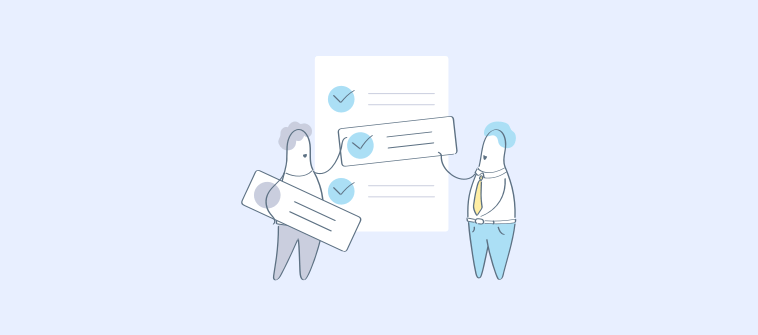Generating new business and growing your company is surely a tough task. Winning new business and then providing world-class customer service is surely not without its ups and downs.
You do your best to build out a team—inside sales, outside sales, customer success—to get them to work as an efficient, customer-focused unit. You train them in how to deal with customers as part of your employee onboarding program.
While you may build the best, most friendly and customer-centric team around—your team will still wind up dealing with difficult customers! It doesn’t matter—some people are just naturally demanding customers and will find any reason to challenge your team on what may seem to be a minor issue.
During such times, remember the customers are ALWAYS right, even when they’re not right!
Your team should be able to have crucial conversations, where they need to pacify a client down, put out a fire or just clarify something. As long as they stay firm, confident and even-keeled, even the most challenging clients can be mollified.
Related Read: Customer Service Skills that Every Employee Needs
How to Deal With an Angry Customer?
Angry customers can be quite a challenge, especially when you have others on hold. Dealing with an angry customer can result in:
- Frustrated operators
- Operator burnout
- Reduced operator productivity
Dealing with a frustrated customer impacts the work cycle of your support operators. And, this further impacts the improvement process of your products and support services. So, before we reach that stage, it is important to learn how to deal with angry customers in the first place.
Quick Navigation
#1. Put Yourself in Their Shoes
You’ve got no idea what pressure your clients are under. Are they difficult because they are a difficult person? Or maybe they got their own demanding customer, or some bad family news, or a financial issue. These things can all boil over into their attitude towards you. You need to be able to relate to and understand their point of view.
It’s called empathy and it’s the most important aspect of customer service. Like in sales, you need to put yourself on the same side of the table as them. It’s not supposed to be an adversarial interaction. If you are empathetic and understanding, it makes working with difficult clients easier.
Regardless of why the customer is upset, it’s critical that you put yourself in their shoes and try to understand their viewpoint. It will help you understand WHY they are upset. When you do this, you are in a much better position to empathize with them.
It also puts you in a better position to problem solve with the customer once you are able to see things their way.
Empathy helps to build trust, and when a client becomes more trusting they are less likely to be difficult.
#2. Active Listening
Active listening entails fully concentrating on what is being said rather than just passively “hearing” what a customer is saying to you.
This helps you to understand the complete message of what the customer is trying to say. There is the temptation to tune the customer out, especially when they are upset and are nagging you. Engaging in active listening can quickly turn a difficult conversation around. In order to do that:
- Pay Attention – Don’t let external distractions or wayward thoughts get you off track
- Confirm That You’re Listening – Verbal acknowledgments let them know they’re being heard
- Don’t Interrupt – It’s rude. Hear them out and wait for a pause in the conversation.
- Summarize And Ask Questions – Offers the opportunity to confirm and clarify your customer’s message
- Respond With Positive Feedback – Highlight the good, avoid the bad
You don’t even need to be on the phone or in front of a customer to actively listen. Using a tool such as live chat software that makes it easy to confirm your involvement, paraphrase the client’s concerns and quickly respond with a list of positive feedback.
See the below video to learn how you can delight your customers using ProProfs Chat:
#3. Take The Blame
Mistakes do happen. Even the most efficient business processes can hit a bump in the road and result in an error. Even the most well-trained, customer-focused teams have screwed up before. Own up to your faults—if they really are yours!
It’s not so much taking the blame for your team as it is about taking responsibility. Taking the blame acknowledges the mistake, taking responsibility means doing something about it.
Responsibility leads to accountability, which promotes an environment of clear and balanced communication with clients and customers.
And when customers are being difficult, taking ownership of mistakes can go a long way with people who—when you really dig down into it—really are just looking to be understood.
#4. Honesty Is The Best Policy
Nobody ever held onto a long-term client by being dishonest.
Demanding customers have been known to ask many questions about a product’s capabilities or a service’s results. To make the conversation easier, you may be tempted to say you can do something that you really aren’t capable of.
It results in Customer Disservice
Stretching the truth just to appease a client is not how you deal with an unhappy customer. For instance, there is a feature your customer wants in the product. But to actually bring it on the floor, your product developers may take months. In times like these, many would recommend you to never say no to a customer.
However, in the case of requests that are beyond your capabilities, it is better you keep them informed. You may be able to fulfill the request, but it’s a stretch for you and those working on it if you try to be the ‘yes man’ here. It would surely be a challenge and potentially result in subpar work quality for your client.
Even if they are angry, people will still respect honesty.
If you can’t do something, be upfront about it. There’s a tendency in the marketplace for people to say they can do something just to get the business and then figure it out on the fly. Unless you are completely upfront with the client about this, don’t pretend you are something you’re not. It will eventually come back to bite you and it’s a sure way to lose a client.
Related Read: Live Chat Etiquette Tips for Being Polite on Live Chat
#5. Stay Cool
Conflict is bound to happen; it’s part of the business. Remaining calm is the best thing to do when the situation gets escalated. Easier said than done, but necessary.
Lashing back out in anger is not how to deal with angry customers, and it’s a sure way to make things worse.
An unkind word, name-calling or a nasty email will not only cost you a client—but possibly your job. It’s not worth it. Stay cool under fire, and never say or write anything that can be used against you.
And if someone is verbally abusing you, you do not have to take it. You can nicely—but firmly—let them know that you have been instructed to get off the phone if the conflict rises to the level of verbal abuse. If you’ve given repeated warnings and they don’t stop, then let them know you are getting off the phone and hanging up and will have a manager reach back out to them.
Beverly Flaxington, author of “Understanding Other People” says, “Just because someone is acting in a difficult manner (yelling or cursing!), you don’t have to put up with it. Just say to yourself—’This is about their inability to control themselves, not about me.’”
You are neither a doormat nor a punching bag. Remain professional at all times, pause when agitated and take a few deep breaths before you do or say anything else. And kill them with kindness!
Even though clients and potential customers can be difficult and overly demanding, they are still the people who put food on your table. Your emotional intelligence—the ability to identify and manage one’s own emotions, as well as the emotions of others—is what will help you successfully navigate the potential situation of dealing with difficult customers.
That’s what your operators can do to handle difficult customers. But how do you train them in the first place?
How to Train Your Support Teams to Deal With an Upset Customer?
There are certain things that your operators need to learn before dealing with frustrated customers. Let’s take a cursory look at them below.
- Never Take Comments Personally
Your customers are angry. However, it is not necessary that they are angry with the operator in the first place. Something about the product or service your brand provides, has disappointed them. And now, you are the operator becomes the vent for them. In such a situation, don’t take any of their comments personally. - Learn Empathy
When your customer is at their lowest, learn to show empathy. So, never let the customer get an impression that they are overreacting in the first place. - Keep Your Facts Clear
Provide adequate reasoning to your customers, and make sure that you have facts to support it in the first place. Also, make sure that you’ve heard the customer correctly before keeping your case forward. - Never Forget to Add a Personal Touch
No matter what medium your customer uses to reach out for help, one thing they expect in times of distress is to receive a personal touch during support. Operators should ensure that as the customer starts the conversation, they have all their previous chats or phone call transcripts ready, along with their history with the brand.
With the right information in hand, the operator will be able to develop a personal experience for the customer. This will give an impression that the brand remembers each and every customer they’ve had, therefore making them feel special.
Other than these, the operators should also:
- Try giving solutions on time
- Give customers the space to vent their anger out
- Let the management know what suggestions the customer gave to improve services better
- Patience is the key to building a good relationship with the customer
Now, that we know how operators need to deal with difficult customers, let’s see how some of the brands have done it so far.
How to Deal With Difficult Customers? [EXAMPLES]
In this section, we aim to explore how some brands have tackled or handled a disgruntled customer in the past along with use cases.
- Preparation in AdvanceProblem: Reaching out to customers without knowing them or their pain points can backfire. But checkout how Zaius turned the tables for their company.Solution: With customer-first slogan, Zaius makes sure that their support team always dives into the customer’s profile before. The operators always prepare in advance so they know the customer inside-out.Katherine Yasi, the Director of the Customer Support and Onboarding team says that it is important to look into any tickets open, or negative reviews submitted through an NPS survey software including the notes that were taken while the customer got in touch with the brand. Looking into these sources help operators get a context on customers before a call and what response are they likely to submit.
- Always Provide Solution With You & Me Approach
Problem: Customers always bring in a challenge that may give you the impression of impossible. However, Denise Hamilton, CEO at WatchHerWork, used the you and me against the problem approach to keep customers delighted with their services. Solution: The company worked towards not being passive aggressive. Instead the operators worked towards bringing in a positive touch to the conversation. They also focused on ways that will help the customers get a fix to their problems. Plus, the company made sure that they stay away from any language that could put the customer into the defensive mode.Empathy plays an important role to not turn the customer against the brand, but against the issue.
- Learn to Find Median Between Needs
Problem: Companies tend to face troubles when they fail to find a median between the customer’s requirement and what’s possible within their band-width. Except, ConversionCore found a solution for it – standing in customer’s shoes (literally).Solution: Benji Rabhan at ConversionCore discusses the importance of finding a median between what the brand wants and what customers seek. Sometimes it may look like a compromise. However, it is more like a sacrifice. And, this sacrifice helps a brand to go a long way with the customers. Plus, the customer feels like coming back to the same brand every time.
Now that we are clear with how to deal with disgruntled customers, it is time to see how they can do it via different mediums too.
How to Deal With Irate Customers Through Live Chat?
There are certain features of a live chat software that can help you deal with an unhappy customer. Let’s take a look at them below.
- Chat Greetings: Reach out to your customers before they do. That’s one thing they expect from a brand too – proactive support. With the help of chat greetings, your operators can be proactive and provide a personalized support experience effectively.
- Monitor in Real-Time: Allow your operators to monitor visitor behavior so they know the visitor better before reaching out to them.
- Chat Routing: Route visitors to the right department and help them get a resolution to the problem faster.
- Canned Messages: Use predefined messages to help operators provide quality answers for frequently asked questions.
FREE. All Features. FOREVER!
Try our Forever FREE account with all premium features!
How to Deal With Irate Customers on the Phone?
Here’s what support agents can do while talking to their irate customers on the phone.
- Be the solution finder
- Always take a few minutes to understand customer’s pain points
- Be the empathizer your customer wants when in a problem
- Learn to be apologetic (customer is always right)
- Always opt for the Zen mode
- Learn to be polite even when the customer is at the edge
How to Deal With Irate Customers on the Email?
Email conversations turn out to be a little confusing for customers, especially if they are not ready to hear out what the company has to say. This probably happens because they were disappointed with the services of the company. So, let’s see how to deal with irate customers on the email below.
- Always and always restate the problem
- Make sure that you ask for further clarification so the customer knows they have someone to share the problem with
- Work towards creating a personalized support for the customers
- Let them know that you will be working on a resolution and when will it be provided
- Positive and polite approach is the way to keep your customers delighted with your services
- Let them know the good news is on the way and that the resolution has been implemented
- Avoid using a rude tone with the customers, this may end up making them even more frustrated
How to Deal With Irate Customers on Social Media?
Besides live chat, email support and phone calls, another channel that customers prefer to reach out to a brand is social media. Let’s see what needs to be done when dealing with irate customers on social media.
- Act upon the problem fast, but make sure that you reach out to others before providing a solution to the customer
- In case you come across a concern that needs to be dealt with the customer directly, take that problem offline
- Learn to take accountability and let them know that the solution will be provided soon
- Give complete validation to the angry customer’s problem so they know that their problem has reached the concerned department for resolution
- Don’t try to get into online arguments, this may make the customer frustrated
- Always ask a colleague to read your response so that the customer never gets to face the brunt of your frustration
We’ve covered most of the channels for you to deal with an unhappy customer and build a delightful experience. While we hope to have answered all the questions that would have popped up in your mind while reading this article, we have also covered some other questions in this section below.
Frequently asked questions about handling difficult customers
Q. How do you not take things personally in customer service?
Well, it can be testing. However, being a professional you need to see the situation objectively. You need to be calm and composed. Plus, always remember that the customer holds no personal grudge against you, their anger and frustration is directed to the brand.
Q. How do you deal with customers always right?
Technically, the customer does not know what they want. It’s up to you how to pitch in an idea that gives the customer the impression that it’s their idea and not yours.
Q. What to say when a customer is yelling at you?
There is nothing to say but listen to them patiently. Once you know that they have said their side of the story, you can move towards providing a solution that helps them faster.
How do you turn angry customers into friends?
Well, the article talks about how you can deal with an upset customer and convert their experience into a delightful journey. The mentioned suggestions will help you convert these customers into friends and brand loyals.
FREE. All Features. FOREVER!
Try our Forever FREE account with all premium features!

 We'd love your feedback!
We'd love your feedback!
 Thanks for your feedback!
Thanks for your feedback!







